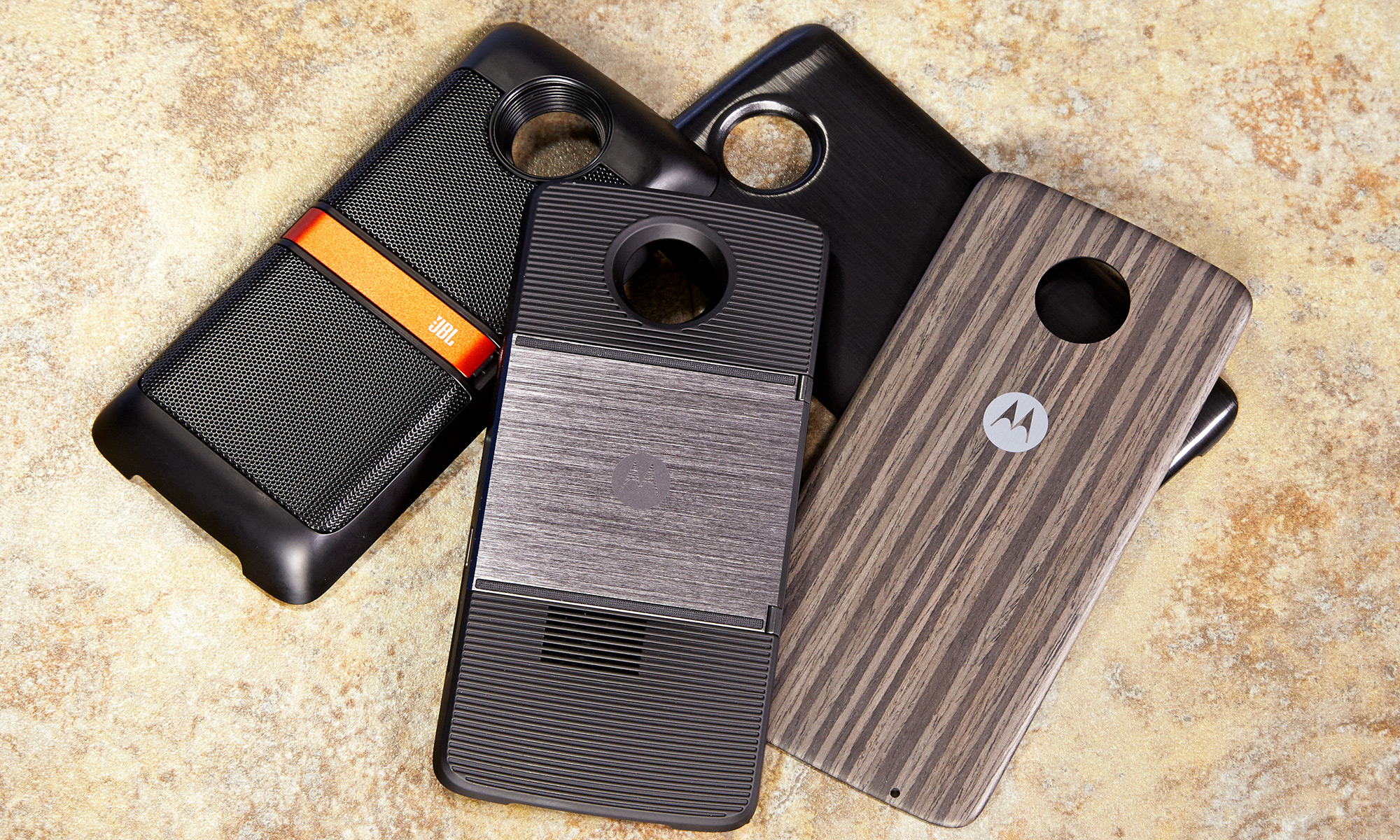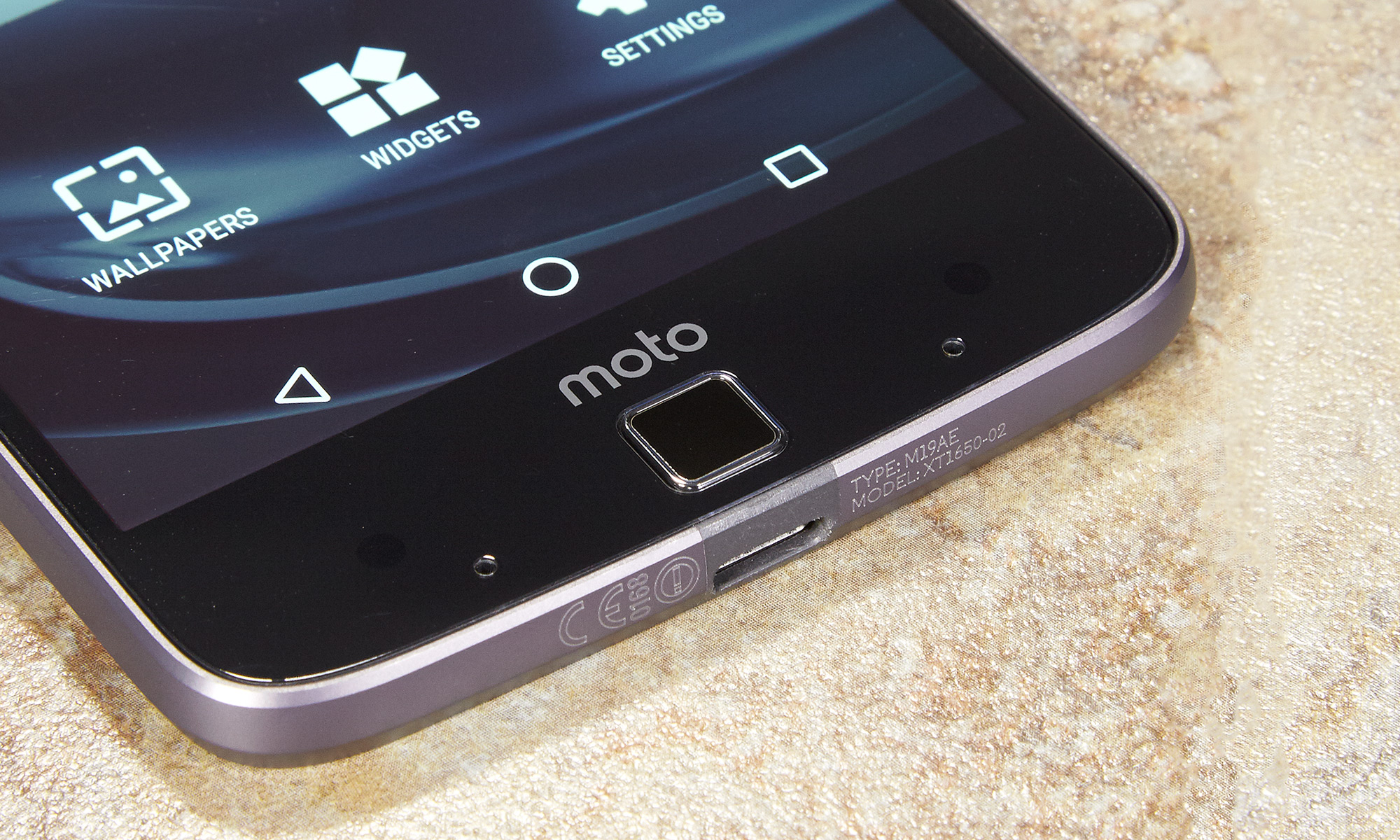Tom's Guide Verdict
With its pair of Moto Z's, Lenovo takes a bold step into the future with easy-to-use modularity, although axing the headphone jack feels a bit premature.
Pros
- +
Easy-to-use Moto mods
- +
Top-notch performance
- +
Upscale design
- +
Z Force sports robust battery life
Cons
- -
No headphone jack
- -
Battery life of Moto Z is below average
- -
Displays could be brighter
Why you can trust Tom's Guide
LG’s modular G5 may have hit the market first, but the new Moto Z lineup from Lenovo may turn out to be the phones that make modularity a household word. With a stunningly thin 0.2-inch body, the $624 Moto Z Droid offers a sleek, sexy take on smartphone portability, while the $724 Moto Z Force features a high-res, 21-megapixel rear cam, shatterproof screen and bigger battery for all-around appeal. Unfortunately, these Verizon-exclusive phones (available starting July 28) also do away with the headphone jack — a design decision smartphone users may not be ready to embrace.
Stylish, function-first design
I've got to give props to Lenovo for coming up with a combination of Gorilla Glass and aluminum that feels high end without aping the style of other phones. There's an unapologetic, almost comically large camera bump on the back, a somewhat out-of-place square, front-mounted fingerprint sensor, USB-C port and exposed pins for use with the Moto family of mods. Lenovo even had the audacity to not include a standard 3.5-millimeter headphone jack on its new phones (which Apple is rumored to be doing with the iPhone 7).









The glass in back also has a subtle, lined pattern that looks classy in every available color — gray, rose gold and white. While I wish the fingerprint sensor doubled as a home button and felt a little smoother, the total Moto Z package is a triumph of function-first design.

The big surprise on the standard Moto Z is how thin it is. Measuring just 0.2 inches thick and weighing 4.85 ounces, Lenovo said it's the thinnest smartphone in the world, and it definitely feels like it is. Almost every person who picked up the phone had an immediate positive reaction to the Moto Z's svelte design.

The 0.28-inch, 5.7-ounce Moto Z Force trades in a bit of sleekness for a 35 percent bigger battery, higher-resolution 21-MP rear camera and a shatterproof screen, resulting in a more well-rounded phone that's better-equipped for life's unexpected tumbles. And while they're not meant for actual dunks or dips, both Moto Z models have a water-resistant coating that should take the fear out of a surprise splash or spill.
For people who like a flat backside, the Moto Z comes packaged with a pretty slick removable wood-grain back plate that smooths everything out at the expense of a little added thickness.
MORE: Best Smartphones on the Market Now
What am I supposed to do without a headphone jack?
One of the most shocking things about the Moto Z is a feature that isn’t there: the headphone jack. Since Lenovo includes a USB-C-to-3.5-mm adapter in the box, the consequences aren't that severe.

In most cases, you can add the USB-C adapter onto the end of your favorite pair of wired headphones and forget anything happened. It can feel a bit awkward at times, but since the adapter fits quite securely onto most headphone plugs, there's no real worry of it falling off.

The real problem about removing the headphone jack arises when you might want to charge your phone while you're still listening to music, like, say, before you fall asleep at night. If you want to do that, you’ll need to use or invest in a pair of Bluetooth headphones.
A simpler, friendlier take on modularity
While the Moto Z isn't the first modular phone we’ve seen this year, it's definitely the easiest to use. All you have to do is slap any one of the currently available mods onto the back of a Moto Z, and the phone takes care of the rest. There's no need to turn off the phone or take apart its lower half like you do when swapping out modules on the LG G5. Firm magnets on the Moto Z ensure that mods stay snugly in place, while the pogo pins create a secure connection for transferring data and power back and forth as needed. The phone even detects when a mod has been attached, so there's essentially no setup, either.

Starting at $60, the Moto Z's power packs are the least expensive and most useful mod. On our battery test, the pack added more than 7 hours to the Moto Z's battery life, although Lenovo claims that you can get up to 22 hours of additional juice. There are even power packs made by well-known designers — including Kate Spade — that add a little flair to your phone, so you won't have to worry about giving up style for power.

The $80 JBL SoundBoost speakers offer the convenience of a typical portable speaker, but without the hassle of Bluetooth pairing. After one week, I found myself preferring JBL's speaker mod over the Bluetooth speakers in my kitchen, thanks to how simple it was to attach the JBL speaker to my phone. The speakers even did a great job of bringing the bass — something most phones tend to struggle with. As a bonus, the speakers come with a built-in battery, so you don't have to sacrifice longevity to pump out the jams. The 0.51-inch-thick speakers do turn the otherwise sleek Moto Z into a bit of tank, though.
Last up is the Moto Insta-Share Projector. Its ludicrous $299 price is hard to justify, but it’s the most fun mod to use. Like its siblings, all you have to do is slap the Insta-Share Projector on the back of the phone and hit the button on the side: voila, you have a portable display that scales up to 70 inches. No more huddling around a tiny display to share a photo, or searching for a cable so you can connect your phone to a TV.
While the projector looks a little dim at its 70-inch max size, it comes with helpful features, such as automatic keystone adjustments, so that your display stays mostly straight no matter how the phone is positioned.
MORE: Best Headphones and Earbuds for Enjoying Music
Lenovo said that the Moto Mod platform will be opened up to third-party developers, which means that there could be an interesting future for Moto Z adaptability, but at this point, the pickings are a bit slim. In comparison, LG currently has four mods available for the G5, with a fifth on the way if the Rolling Bot ever gets released.
Rich colors, but the screen could be brighter
If you want rich colors and deep blacks, AMOLED really is the way to go, and the 5.5-inch QHD displays on the Moto Z and Z Force don't disappoint. For mobile movie watchers, these displays really bring the action to life with fantastic contrast and great dynamic range that make the wide vistas in the Assassin's Creed movie trailer hard to stop watching. And if you prefer more neutral color tones, Lenovo has thoughtfully added a standard color mode in the phone's display settings.

However, if I could make a small improvement, a little more brightness would be nice. The Moto Z and Z Force put out 326 and 315 nits of brightness, respectively, which is less than the 433-nit average for smartphones. The Samsung Galaxy S7 Edge was even brighter at 530 nits, as was the HTC 10 ( 371 nits) and LG G5 (354 nits), although not by as much.
Like most AMOLED displays, the Moto Z's can reproduce a wide range of colors. We measured the Moto Z as covering 188.6 percent of the sRGB spectrum, while the Z Force was slightly more limited at 178 percent. These numbers dwarf phones with traditional LCD displays such as the LG G5 (123 percent) and even the surprisingly colorful HTC 10 (163 percent). The performance of the Moto Z's was on a par with other AMOLED-equipped phones like the Galaxy S7 Edge (189 percent).
The Moto Z's also have pretty solid color accuracy, notching Delta-E ratings of 2.2 for the Moto Z and 2.4 for the Moto Z Force. (Numbers closer to zero are better.) These stats stack up favorably to other top-tier phones, including the S7 Edge (2.9), HTC 10 (3.6) and LG G5 (2.6).
Full flagship power
Featuring a Qualcomm Snapdragon 820 processor, 4GB of RAM, 32GB of built-in storage (64GB if you upgrade) and microSD card support up to 2TB, the Moto Z has no problems keeping up with the performance of other flagship handsets.

The phone always feels snappy, no matter if you're trying to catch a Clefairy in Pokemon Go or simply scrolling through your mountain of apps; it's a smooth ride the whole time.

Our benchmarks back this up, as the Moto Z and Z Force scored 5,612 and 5,596, respectively, on Geekbench 3, which measures overall performance. Those scores are actually a tiny bit better than what we've seen from Samsung Galaxy S7 Edge (5,448), the HTC 10 (5,107) and the LG G5 (5,357).

We saw similar results on 3DMark's Ice Storm Unlimited graphics test, which saw the Moto Z and Z Force score 28,306 and 29,502, respectively. The Samsung S7 Edge was equally proficient with a score of 29,851, while the HTC 10 and LG G5 were slightly behind at 26,955 and 27,118, respectively.
MORE: Best Cheap Unlocked Smartphones
It was the same story for web browsing, too. The Moto Z and Z Force both scored 54 on the JetStream JavaScript test, which was slightly higher than what the Galaxy S7 Edge (49.9), HTC 10 (53.5) and LG G5 (51.8) turned in.
Sharp cameras, but still not on Samsung's level
One of the big differences between the standard Moto Z and the Z Force are their rear cameras. Both feature 5-megapixel shooters up front, but the Z Force features a 21-MP camera in back, while the Z gets a 13-MP cam. As a result, each phone has different strengths when it comes to photos, which may help you decide which model to get.
In bright light, the Z Force is the stronger shooter. With 8 extra megapixels, the Z Force simply captures more information than the standard Z. The Z Force gives you the freedom to crop in when you need to, or when you just want to read all the signs on a crowded street.

At a shot at the newly opened Oculus station in NYC, I noticed another couple quirks about these phones' cameras. The standard Moto Z tends to shoot a bit warmer, with more red, orange and yellow tones, while the Z Force’s photos often end up looking a little cool.

No matter which Moto Z you use, when compared to photos from a Galaxy S7 Edge, pics from both Moto Z's look underexposed.

In low light, photos are more of a mixed bag. The 13-MP Moto Z shots are brighter, though the Z Force's pics are often less grainy, and once again, feature better details. You can see this in a tricky shot overlooking the Hudson River, where the Z Force's photo features much less noise in the night sky. The regular Moto Z's pic featured more light and brighter whites, especially on the flag in the foreground.

When compared to the S7 Edge, Samsung’s phone did a much better job of not blowing out the lights on the buildings in the background, which leads to a more pleasing and well-exposed photo.
I also noticed that at night, both Moto Z's were more demanding about having a steady hand than the S7 Edge. On top of being prompted to keep still after I hit the shutter, both phones took longer to focus and snap pictures back to back, whether HDR was on or off.
In front, both 5-MP cameras snapped satisfyingly sharp selfies, with proper exposure and a ton of detail.
Z Force leads the way in battery life

With a time of 10 hours and 15 minutes on the Tom's Guide Battery Test (continuous web surfing over LTE on Verizon’s network), the Moto Z Force's 3,600-mAh battery sports better life than most flagship phones. The Samsung Galaxy S7 Edge and the HTC 10 were relatively close, with times of 10:09 and 9:56, respectively, while the LG G5 lasted 2 hours less with a time a 7:57. Unfortunately, the standard Moto Z and its smaller 2,600-mAh battery was less impressive, as it lasted just 7 hours and 35 minutes on our test. I guess that's the price you pay for such a thin body.
MORE: Smartphones with the Longest Battery Life
Too much Big Red bloat
Both the Z and Z force continue Motorola's tradition of featuring stripped-down, nearly stock versions of Android. However, like past phones, there are a handful of lightweight enhancements that make Android 6.0 a bit more friendly.
Moto Actions uses gesture recognition so you can do things like launch the camera with a twist of your wrist or turn on the flashlight by doing a double chop while holding the phone. Moto Voice allows you to set custom phrases to trigger voice search, and Moto Display gives you more control and privacy over what does and doesn't show up on your phone's lock screen.
The experience goes south, however, when you discover all the bloat that Verizon preloads on the Moto Z. On top of the six Verizon apps that do more harm than good, there are also more than a handful of third-party apps such as Panda Pop and Genies & Gems gunking up your phone. The only app worth the space it takes up is the NFL Mobile app, which, for an additional monthly subscription, lets Verizon subscribers stream football games right on their phone.
Bottom line
I really like how progressive the Moto Z and Z Force feel. Both phones feature a refreshing function-first approach to design. The standard Moto Z pushes the boundaries of smartphone thinness, while the Z Force comes with an even sharper camera, longer battery life and a shatter-resistant screen. Add in a more approachable take on smartphone modularity than what’s currently available, and you get a phone that's a bigger success than the LG G5 in almost every way.
Unfortunately, I'm not sure the world is ready for the death of the headphone jack. And at $724, the Z Force, which is my preferred Moto Z, still doesn't give you as much as a $650 Samsung Galaxy S7 Edge, which features similar horsepower and battery life while also delivering a better overall camera, more potent water-resistance and a brighter screen. Both Moto Zs are top-notch flagship phones, but they need more mods to put them over the top.
Sam is a Senior Writer at Engadget and previously worked at Gizmodo as a Senior Reporter. Before that, he worked at Tom's Guide and Laptop Mag as a Staff Writer and Senior Product Review Analyst, overseeing benchmarks and testing for countless product reviews. He was also an archery instructor and a penguin trainer too (really).
